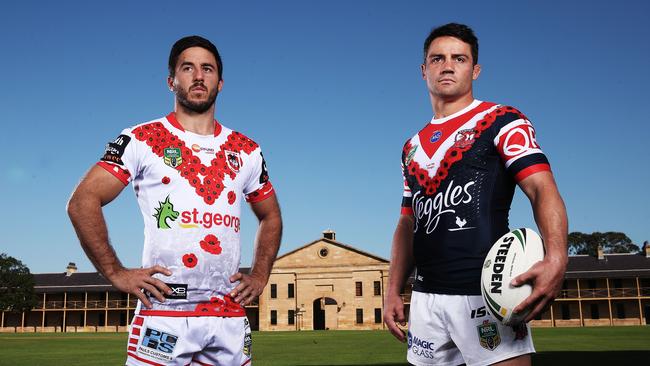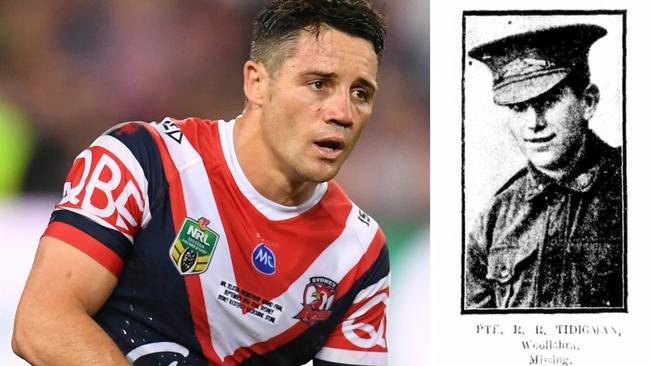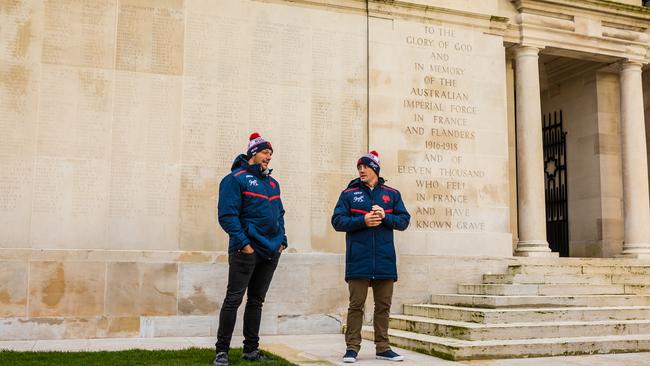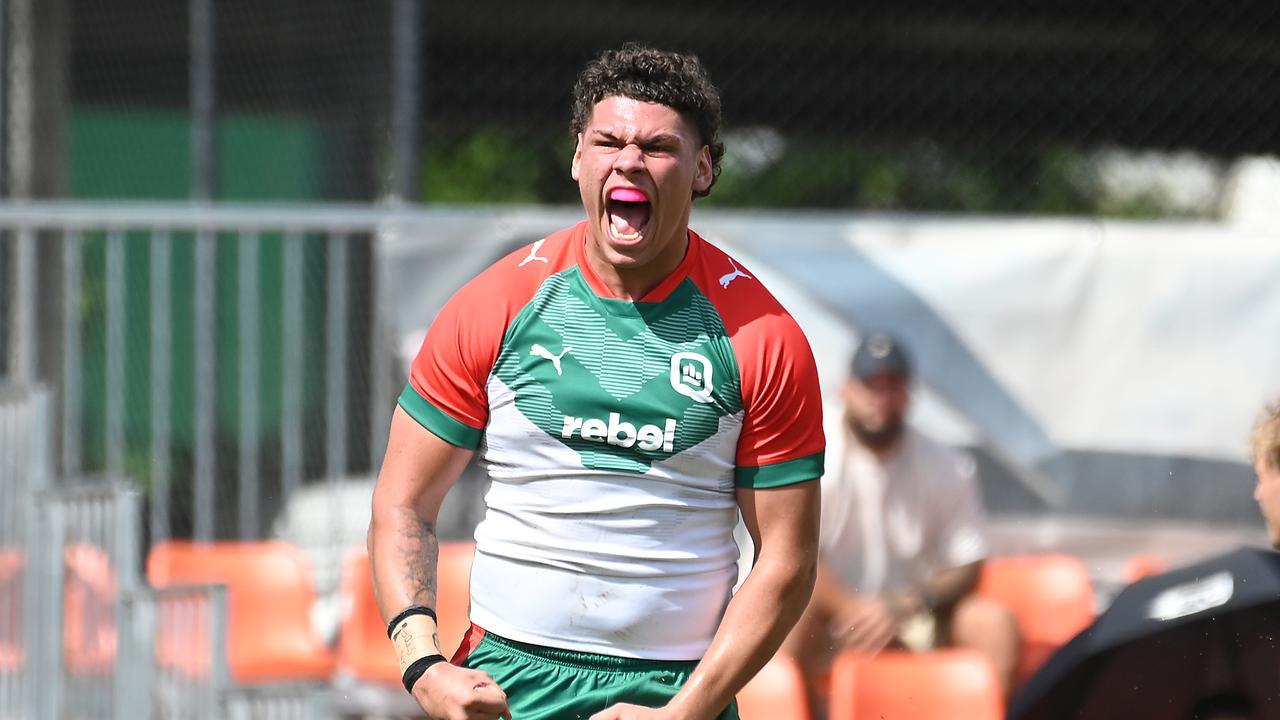Cooper Cronk on how he is inspired by the Anzac sacrifice
Cooper Cronk is tough, everyone in rugby league knows that. But the Roosters champion says what he does is nothing compared to those who gave the ultimate sacrifice.
Cooper Cronk is an inspiration, a rugby league player who personifies modern day courage and class.
He not only speaks with respect, but he plays with it, treating his opposition the same way, no matter how tough it gets during the heat of battle.
And while he is known for his composure under pressure, his toughness will be forever etched in the game’s folklore after playing last year’s grand final with a busted shoulder.
It was a performance Trent Robinson rightfully described as the bravest he had witnessed on a rugby league field.
But when the Sydney Roosters’ champion playmaker this week spoke about what it means for him to be able to play in Thursday’s Anzac Day game against St George Illawarra, Cronk told his own story about another footballer’s bravery that was as heroic as it was humbling.

It related to a former Eastern Suburbs player who now inspires Cronk some 106 years after Robert Tidyman first ran on to the famous Sydney Cricket Ground.
In his day, records state Tidyman only stood at 168cm (5 foot 6 inches in the old scale) and weighed 70kg.
By today’s standards, the diminutive five-eighth would not have been regarded as big enough to survive in the rough and tumble world of professional NRL.
To put his size in perspective, Cronk is 178cm and 88kg.
Even though a historic newspaper report once said of Tidyman: “There has never been a better tackler”.

Cronk learned of Tidyman’s rugby league career — and his ultimate sacrifice at the Battle of the Somme — when Robinson set his players a task before the Roosters left for the World Club Challenge back in February.
Ahead of their clash in England, Robinson challenged his players and staff to try and find a family connection to World War I before their visit to the Western Front.
If the players didn’t have a family connection, they were asked to research someone from the area they grew up.
But as Cronk explained: “I didn’t have anyone directly in my family and I grew up in Brisbane, which is a big city that I am not so connected to now, being away for 20-odd years.”

After searching the internet, Cronk found himself mesmerised by Tidyman’s story.
Like Cronk, Tidyman was originally from Queensland but moved to Sydney as a young boy to live at Woollahra.
He was described as a talented schoolboy and was selected for Eastern Suburbs as a 21-year-old for the first premiership game played at the SCG in 1913.
While Tidyman only played three seasons of first grade, he was also part of the historic Rorke’s Drift Test at the SCG in 1914.
Cronk himself played in the commemorative Test during the 2014 Four Nations in which players from Australia and England wore special jerseys based on those worn by the teams in 1914.
Although he played in 1915, Men of League records show that Tidyman only played nine matches because of a broken arm.
LISTEN! Matty with Paul Kent and James Hooper dissect the spin behind Phil Gould’s exit from the Panthers and reveal just how one match at Parramatta’s new stadium has completely changed the Sydney rugby league scene.
It was later that same year Tidyman enlisted in the Australian Army so he could join his two younger brothers fighting in the war.
Tidyman sailed off to England on April 9, 1916, and then to France.
It is recorded that Tidyman joined the fighting on the Western Front on September 25, 1916.
Tidyman was later reported missing on November 14, though it wasn’t until 2017 that he was finally declared killed in action.
While his body was never recovered, it was claimed Tidyman could have been taken out by a sniper while guarding prisoners in the trenches.
His name is listed on the Australian memorial at Villers-Bretonneux, with around 11,000 other Australians that have no known grave.
Cronk spoke with awe at how he and his teammates felt upon their visit to the Western Front.
“I am not one who compares sport and war because I just don’t think it is fair,” Cronk said.
“But to walk the same footsteps as those men and women did at such a young age … I was in awe and a little uncomfortable to be honest.
“I understood war and I respect the history of Australia. But I never understood scale and magnitude of which it was, because they paid the ultimate sacrifice for us to do what we are doing right here.
“When we play footy, most people say we are pretty tough. But I am not as tough as what they did.
“I could not put my hand up and did what they did for this country.”
LEST WE FORGET: Australian rugby league players who went to war and never returned
WORLD WAR I
Charlie Savory
James Williams
George Duffin
Frank Cheadle
Herbert ‘Nutsy’ Bolt
George Hardy
Robert Tidyman
Charles Rothwell
Harold Corbett
Johnno Stuntz
Sydney Sparrow
Edward Buckley
Alexander McDowell
Tom Bruce
Edward Baird
Ernest Gowenlock
Percy White
World War II
Peter Hickey
Syd Christensen
Vince Edwards
Maurice Fitzgerald
Artie Carnell
Harry Allwork
Ken Wood
Keith Pettiford
William Ryan
Charles McKay
Isidor Sender
Len Brennan
Alf Birtles
Harold Dalton
Jack Lennox
Alan Keato
Jack Simpson
Gerry Atwell
Neville Butler
Spencer Walklate
Jack Redman
Hylton Davie


